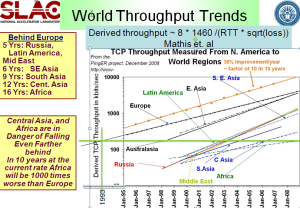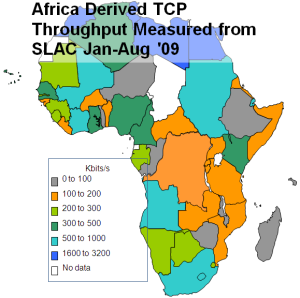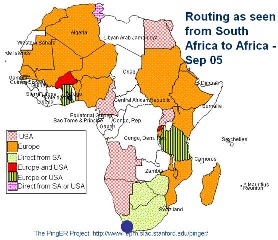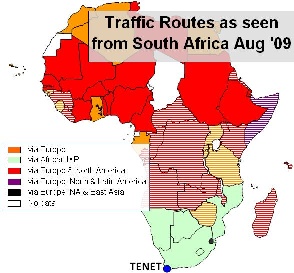...
With the 2010 Soccer World Cup fast approaching the Seacom undersea fibre optic cable, plugging East Africa into high speed Internet, went live on Thursday July 23, 2009 - as reported by the BBC and CNN. Such a cable should dramatically reduce the cost of bandwidth measured in $/Mbps, reduce the Round Trip Times (RTT) from >~ 480 ms for a geostationary satellite, down to 200-350ms by using shorter distance terrestrial routes, and by increasing the capacity reduce the losses and jitter.
In this case study we look at the current state of Internet access for Africa as measured by the PingER project and also at the effect of the new submarine cable connections on the RTTs to countries of Africa as seen from the SLAC National Accelerator Center near San Francisco. THe The main effects seen so far are on the RTTs for selected sites that have converted to using the terrestrial links. As the new routes stabilize and more and more customers, e.g academia and commercial organizations, subscribe to the service, we can expect to also see lower losses and jitter and higher through-puts together with a wider impact on deployment.
...
The throughputs measured to Africa from N. America for the last decade are shown below in the left hand figure. It is seen that not only do African sites lag the rest of the world in throughput, being roughly in the state that European sites were over a decade and a half ago, but also they are falling further behind withy with time. Further, bear in mind that for Africa, Mediterranean countries and South Africa have the better perfomance and E. Africa is the worst off (see the the middle left map). Thus the arrival of a terrestrial submarine fibre cable link to the rest of the world for E. Africa is a very significant development.
...
<ac:structured-macro ac:name="unmigrated-wiki-markup" ac:schema-version="1" ac:macro-id="0f619dc7e4804378-2b55c579-49374ff7-a01bb024-cf6341c829a7a82d3c741b50"><ac:plain-text-body><![CDATA[ | Throughput from SLAC to Regions of the World | Derived Throughput from SLAC to Africa Jan-Aug '09 [[xlsx | ^africa-thru-aug09.xlsx]] | MinRTT from SLAC - Aug. 2009 [[xls | ^map-africa-minrtt-aug2009.xls]] | ]]></ac:plain-text-body></ac:structured-macro> |
|---|---|---|---|---|---|---|
|
|
|
The striking number of countries in Eastern and Central Africa with minimum RTTs of >400ms is indicative that they were using GEO-Stationary (GEOS)satellite links. The new cable should also result in less loss and jitter due to the reduction in congestion caused by the increase in capacity.
At the moment the SAT-3/WASC/SAFE fibre has been in place for some time and connects up several countries on the W. Coast of Africa. The Seacom line is not the only fiber-optic cable project on Africa's east East coast — others include the Eastern Africa Submarine Cable Systems (EASSY), The East African Marine System (TEAMS) and Lion — but it will be the longest and have highest capacity (1.28 terabytes per second). The EASSY and TEAMS are designed to build out African telecommunications networking, but Seacom is the only line that directly will connect east coast urban areas in Kenya, Madagascar, Mozambique, South Africa and Tanzania to France and India. TEAMS landed in Mombasa early June 2009 and is currently undergoing testing while EASSY and Lion are expected to be operational by mid-2010. Maps of the various fibres is shown below and more details are available here.
...
<ac:structured-macro ac:name="unmigrated-wiki-markup" ac:schema-version="1" ac:macro-id="7a48ee8559a896a7-fc89c897-4767433b-afb89909-e5578f5040534f779045d2ef"><ac:plain-text-body><![CDATA[ | Routing from South Africa to African Countries (Sep '05) | Routing from South Africa to African Countries (Aug '09) [[xls | ^routing-africa-aug2009.xls]] | Routing from Burkina Faso to African Countries (Aug '09) [[xls | ^routing-africa-aug2009.xls]] | ]]></ac:plain-text-body></ac:structured-macro> |
|---|---|---|---|---|---|---|
| |
|
...





